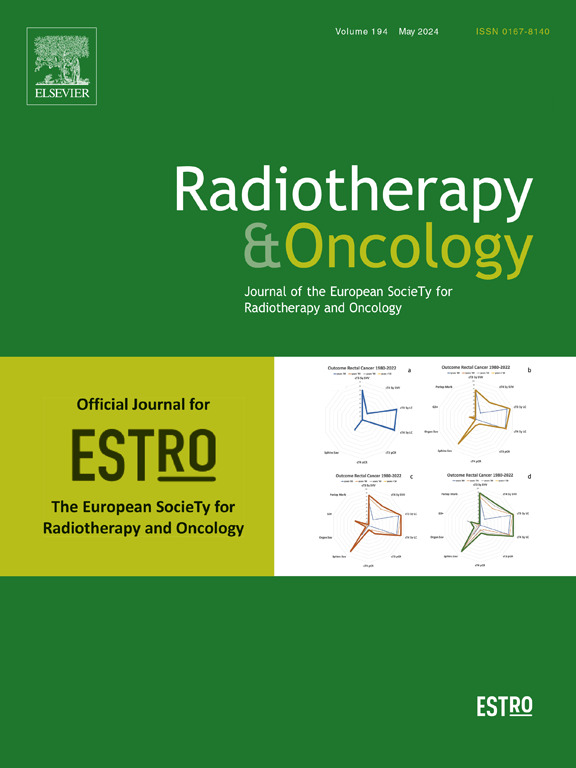评估基于深度学习的合成CT生成中的多个MRI序列,用于头颈部肿瘤的仅磁共振放射治疗。
IF 4.9
1区 医学
Q1 ONCOLOGY
引用次数: 0
摘要
目的:本研究探讨了多个磁共振(MR)序列对基于深度学习的头颈部合成计算机断层扫描(sCT)生成质量的影响。材料与方法:收集26例头颈部肿瘤患者的12个MR序列(t1术前、t1后、T2各4张Dixon图像)。使用U-Net框架训练了14个独特的深度学习模型,使用多个MRs作为输入来生成sct。使用平均绝对误差(MAE),骰子相似系数(DSC)以及Gamma通过率来比较不同多通道MR-sCT模型的sct与实际CT。结果:使用所有可用的MR系列获得的sct具有最低的像素误差(MAE = 80.5 ± 9.9 HU),但增加通道也增加了人工组织,导致较差的自动轮廓和较低的剂量学准确性。T2方案的模型通常导致sct质量较差。造影T1与所有Dixon是最好的多通道图像MR-sCT模式,持续高排名为所有sCT质量测量(平均DSC所有结构 = 80.0±13.6 % %,全球伽马通过率 = % 97.9±1.7 % 2 % / 2毫米剂量标准和20 %最大剂量阈值)。结论:使用来自预对比T1序列的所有Dixon图像作为多通道输入的深度学习网络产生了最具临床可行性的sct。我们提出的方法可能使mr放射治疗计划在头颈部癌症的临床设置。本文章由计算机程序翻译,如有差异,请以英文原文为准。
Assessing multiple MRI sequences in deep learning-based synthetic CT generation for MR-only radiation therapy of head and neck cancers
Purpose
This study investigated the effect of multiple magnetic resonance (MR) sequences on the quality of deep-learning-based synthetic computed tomography (sCT) generation in the head and neck region.
Materials and methods
12 MR series (T1pre-, T1post-contrast, T2 each with 4 Dixon images) were collected from 26 patients with head and neck cancers. 14 unique deep-learning models using the U-Net framework were trained using multiple MRs as inputs to generate sCTs. Mean absolute error (MAE), Dice Similarity Coefficient (DSC), as well as Gamma pass rates were used to compare sCTs to the actual CT across the different multi-channel MR-sCT models.
Results
Using all available MR series yielded sCTs with the lowest pixel-wise error (MAE = 80.5 ± 9.9 HU), but increasing channels also increased artificial tissue which led to poorer auto-contouring and lower dosimetric accuracy. Models with T2 protocols generally resulted in poorer quality sCTs. Pre-contrast T1 with all Dixon images was the best multi-channel MR-sCT model, consistently ranking high for all sCT quality measurements (average DSC across all structures = 80.0 % ± 13.6 %, global Gamma Pass Rate = 97.9 % ± 1.7 % at 2 %/2mm dose criterion and 20 % of max dose threshold).
Conclusions
Deep-learning networks using all Dixon images from a pre-contrast T1 sequence as multi-channel inputs produced the most clinically viable sCTs. Our proposed method may enable MR-only radiotherapy planning in a clinical setting for head and neck cancers.
求助全文
通过发布文献求助,成功后即可免费获取论文全文。
去求助
来源期刊

Radiotherapy and Oncology
医学-核医学
CiteScore
10.30
自引率
10.50%
发文量
2445
审稿时长
45 days
期刊介绍:
Radiotherapy and Oncology publishes papers describing original research as well as review articles. It covers areas of interest relating to radiation oncology. This includes: clinical radiotherapy, combined modality treatment, translational studies, epidemiological outcomes, imaging, dosimetry, and radiation therapy planning, experimental work in radiobiology, chemobiology, hyperthermia and tumour biology, as well as data science in radiation oncology and physics aspects relevant to oncology.Papers on more general aspects of interest to the radiation oncologist including chemotherapy, surgery and immunology are also published.
 求助内容:
求助内容: 应助结果提醒方式:
应助结果提醒方式:


